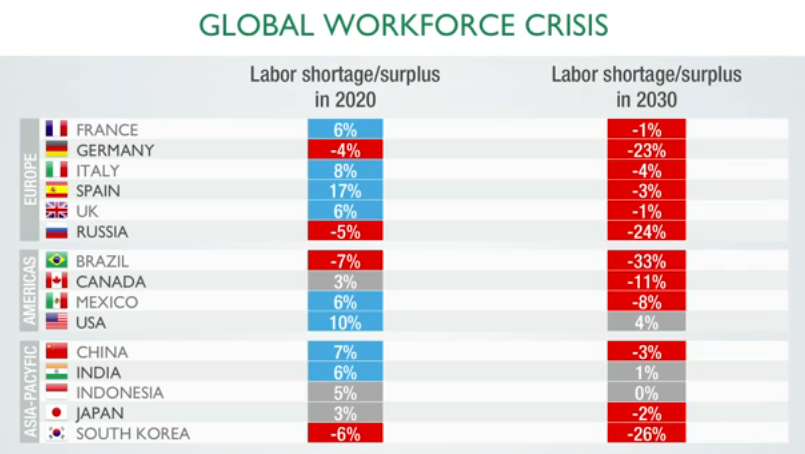19.09.2017
Values based employee leadership, why bother?

‘People are the most important asset in our company’ ranks high among overused statements. I cringe every time I hear it, because of the absence of action associated with those words in many cases. Obviously, lack of action might not be a problem, if there are plenty of skilled employees to choose from, but we know that the reality is different as shown in the above image about the global workforce crisis. Companies like Google, Apple, Amazon, etc. have realized the truth about this cliché and reap the benefits of engaged employees. Still many others are trapped in a conundrum of maximizing profits, and managing employee turnover especially trying to keep top talent in-house. The recent study by Ahonen, Aura, et. al. (Management of Strategic Well-being (2016) shows among the key findings that most Finnish companies still offer only medium level healthcare and some support for physical exercise, but that wellbeing is part of (measured) strategy in only about 9% of all companies. I guess the question is “how to show your staff that you truly care while still remaining profitable?”
This is not a new issue and most companies have tried one, if not a mix of wellbeing initiatives, whether it is through food, exercise or other programs. But how many of you have had your employer offer wellbeing programs that you used for only 1-2 weeks or never at all? Well, you are not alone. Studies from RAND Health and Gallup show that only 24% of employees participate in current wellbeing programs, and those are the ones who need it the least. In fact, there is growing suspicion and distrust among employees regarding these programs. For a company wellbeing program to be successful, the underlying individual needs of your staff have to be identified because people are different, and the ‘one solution fits all’ approach does not work. However, this is much harder in practice, due to the work associated with bringing in different individual programs and the difficulty of choosing one out of so many wellbeing programs, let alone multiple programs. Implementation will be a challenge, and correct and unbiased measurements of the value of the investment becomes difficult to assess.
The solution should be centered on the following four points:
1. Understand the real needs of your employees: Privacy and confidentiality are pertinent to success, otherwise suspicion and distrust will increase. Therefore, an external evaluation is recommended.
2. Being on the same page and values based leadership: What are the company and individual values and strategy, and how are they reflected in everyday actions. Align these and bridge the gap where needed. In general, only 30% of employees know their company’s values and strategic goals.
3. Design a program that fits the exact needs: Since the one program fits all model does not work as evidenced with the 24% participation rate, try to have different groups that are more similar in terms of their wellbeing needs.
4. Evaluate independently from the wellbeing supplier companies: Create an internal and external evaluation to calculate the returns and value of investment. External, because the supplier is naturally biased, and internal if you have the resources.
Values based leadership means that your personal and organizational goals are aligned, but as it is innate to all of us, we not only want to be part of a group, but need to feel valued in it. Therefore, being profitable and responsible in the long run can only happen when employees feel valued and their voice truly matters.
The old way of providing one wellbeing program for everyone, maybe just to show you are doing something, may lead to lower employee engagement and higher turnover. In an environment where the talent pool is continuously shrinking, one of your main competitive advantages is to value employees with actions that really matter to them. No matter what your company culture is like, or how big or profitable your company is, if your employees feel you are only interested in their short-term productivity, and not their overall wellbeing, chances are you will not succeed in the long run. This is reflected in studies such as Deloitte’s 2016 millenial survey which shows that ‘64% of millenials focus on their own agenda.’ ‘Work should provide us all with the opportunity to fulfil our own needs and potential, in ways that suit our situations throughout our lives’ (Taylor review of modern work practices). During our adult lives, and while we are awake, we spend about 50% of our time at work. It therefore goes without saying that work should help us fulfil the needs that are important to us. To do that, a good balance is pertinent, spurred on by values based leadership.
If you are interested in gaining more insight as to how to help your employees become more engaged through wellbeing, join us at Henry ry’s office on Thursday 5.10.
Pierre Jallow

